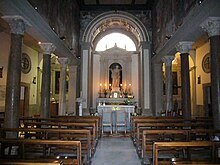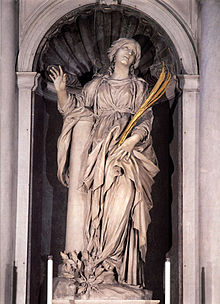Santa Bibiana
| Basic data | |
|---|---|
| Patronage : | St. Bibiana |
| Consecration day : | |
| Address: | Via Giovanni Giolitti, 154 00185 Roma |
Santa Bibiana is a church in Rome . It is considered remarkable in several ways: The facade was the first major architectural commission for Gian Lorenzo Bernini ; The high altar with the sculpture of the titular saint also comes from him ; and here Pietro da Cortona executed the earliest cycle of frescoes in his new style.
location
The church is in the XV. Roman Rione Esquilino , about 650 meters northwest of Porta Maggiore . This location on the Via Tiburtina , which was preferred in late antiquity , has changed; the church is now wedged between the track in front of the confluence with the Roma Termini station and a busy street.
History and building history
According to the written sources and the results of the archaeological excavations, several sacred buildings were built one after the other :
In 363 a small place of worship was built in honor of the young martyr Bibiana , who, according to tradition, was scourged to death here in the 4th century.
Pope Simplicius had an early Christian church built in 468, which is reported in Liber pontificalis (I, 249): "He consecrated the basilica within the city of Rome near the Palatium Licinianum for the blessed martyr Bibiana, where her body rests." the Horti Liciniani and the palace of the emperor Licinius Gallienus (253-268) were in antiquity .
Under Pope Honorius III. The new building of a flat-roofed three-aisled basilica was built around 1220 . It had a semicircular apse facing southeast and two flat closed side apses , as well as a vestibule and a campanile . The short central nave was separated from the side aisles by four architrave columns on both sides; the presbytery was separated by marble barriers. The apse originally had a mosaic , the remains of which are now kept in the Museum Centrale Montemartini .
The basilica fell into disrepair in the centuries that followed, until the chapter of Santa Maria Maggiore began a renovation in 1624, in a return to early Christian traditions in the course of the Counter-Reformation . In August 1624, bones were found here that were considered relics of St. Bibiana apply. That was the reason for Pope Urban VIII (1623–1644) to commission Gian Lorenzo Bernini, who was then only 26 years old, with a thorough restoration; but the old form ( forma vecchia ) should be retained. The architect converted the semicircular apse into a transverse rectangular main apse and closed the aisles with rectangular chapels. On the west side he built a new facade in the style of the time. The 28-year-old Pietro da Cortona and Agostino Ciampelli received the commission for the painting . All restoration work was completed in 1626.
Exterior
The church is famous for its extraordinary facade. Bernini built a two-story and three-axis portico facade, maintaining the width of the basement on the upper floor. Carlo Maderno had previously used this type of facade when building the facade of St. Peter's Basilica . The strong emphasis on the central risalite is striking . The basement is divided by three arcades ; Ionic pilasters are presented to the pillars . The structure is retained on the upper floor, but no longer in arcade form. The side wall surfaces are broken through with simple windows, while in the middle part of the facade an aedicule was attached above the window and a small balustrade was faded in. The capitals follow a modification of the Tuscan order; the central projection is crowned by an openwork triangular gable. This special emphasis on the middle window as a stage is explained by the religious and cultic custom that from there the head relic was shown to the people once a year on the feast day of the church patroness, on December 2nd. Balustrades and flame vases decorate the top of the facade.
Interior
Due to the basilica structure of the small church, it has three naves and is flat-roofed. The eight columns, put together in pairs, are antique. To the left of the entrance there is another small antique column; it is said to be the column on which the saint was scourged.
The windowless upper aisle contains on the left side the first cycle of frescoes by Pietro da Cortona; the right side was painted by Agostino Ciampelli. Both fresco cycles show scenes from the life of St. Bibiana . Da Cortona worked here for the first time in his new, antique fresco style, influenced u. a. by Polidoro da Caravaggio : the martyrs are portrayed as heroes of ancient times . This fresco made da Cortona famous at once and his new style set the trend in Roman art.
The high altar is also a work of Bernini; he placed his sculpture of the patron saint in a central niche of the altar and thus created a new type of altar. The saint is shown with the pillar of torture and the palm tree as symbols of victory, as she looks up to heaven. The severity of the altar architecture is in tension with the saint, depicted in motion. Bernini calculated the dramaturgy, especially the lighting: a specially opened shaft lets light fall onto the sculpture and the saint stand out even more. An alabaster urn incorporated in the high altar contains the relics of the church patroness.
literature
- Hugo Brandenburg : The early Christian churches in Rome from the 4th to the 7th century. Schnell & Steiner, Regensburg 2013, p. 233f.
- Hans Georg Wehrens: Rome - The Christian sacred buildings from the 4th to the 9th century - A Vademecum . Herder, Freiburg 2016, p. 263f.
- Anton Henze u. a .: Art guide Rome . Reclam, Stuttgart 1994, p. 156.
- Walther Buchowiecki : Handbook of the Churches of Rome. The Roman sacred building in history and art from early Christian times to the present. Volume 1, Hollinek, Vienna 1967, p. 468ff.
- Stefan Grundmann (Ed.): Architectural Guide Rome . Menges, Stuttgart / London 1997, ISBN 3-930698-59-5 , pp. 199f.
- Rolf Tomann (Red.): The art of the baroque: architecture, sculpture, painting . Könemann, Cologne 1997, ISBN 3-89508-991-5 .
Individual evidence
- ↑ Lexicon for Theology and Church, Freiburg 2006, Volume 2, Col. 414
- ↑ Walther Buchowiecki: Handbook of the Churches of Rome. The Roman sacred building in history and art from early Christian times to the present. Volume 1, Vienna 1967, p. 468.
- ^ Hugo Brandenburg: The early Christian churches in Rome from the 4th to the 7th century. Regensburg 2013, p. 233.
- ↑ Hans Georg Wehrens: Rome - The Christian sacred buildings from the 4th to the 9th century - Ein Vademecum , Freiburg 2016, p. 263f. with floor plan Fig. 35.
- ^ Stefan Grundmann (ed.): Architectural Guide Rome . Stuttgart / London 1997, pp. 199f.
- ↑ Wolfgang Braunfels in: Lexikon der Christian Ikonographie, Freiburg a. a. 2004, Volume 5, Col. 398f.
Web links
Coordinates: 41 ° 53 ′ 43.9 " N , 12 ° 30 ′ 33.4" E



